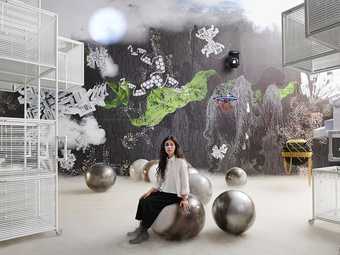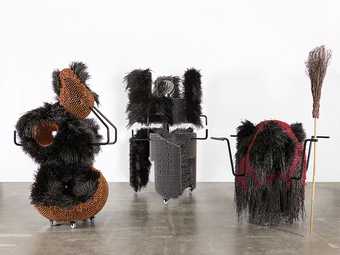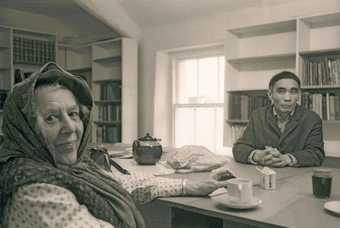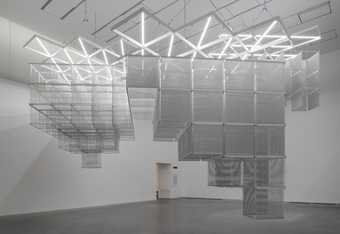
Haegue Yang in her exhibition When The Year 2000 Comes at Kukje Gallery, Seoul, 2019
© Haegue Yang, courtesy Kukje Gallery, Seoul, photo: Chunho An
A flotilla of candy-coloured origami forms floats in the dirty, grey puddles of an asphalt backyard. They are blown along and scattered by intermittent gusts of wind, while a voiceover attempts to make sense of shifts of place, social context, and general feelings of dislocation. This sequence from Haegue Yang’s early video Unfolding Places (part of Video Trilogy 2004–6) has remained vividly in my imagination since I first saw it in Berlin in 2004. Its unlikely juxtaposition of alluring handcrafts with a bleakly urban setting echoes the narrative’s pull between the desire to belong and a relentless pursuit of place.
Yang, who was born in Seoul in 1971, came to Frankfurt in 1994 to study at the Städelschule, and moved to Berlin in 2005, where she still lives. Since 2014, she has also maintained a studio in Seoul, splitting the production of her work in a manner that reflects her complex biography. That her website is titled heikejung.de may be a joking reference to the mispronunciations of her name in her adopted home, but it also hints at the small-scale misunderstandings bound up in her daily cross cultural straddle.
Yang avoids pat ideas of globalisation, however, and her conceptions of migration and diaspora are explored not simply in terms of self and other, but as various possible selves and others that intertwine. Since the mid-2000s, when she began to use domestic appliances and other familiar found objects in her sculptures, Yang’s works have developed into series characterised by an almost genealogical evolution, like branches of a family tree. One of the earliest examples of these is the Series of Vulnerable Arrangements, which began in 2006. In these works, wheel-mounted metal stands, such as those used in hospitals for IV drips, were adopted as mobile armatures on which to drape all kinds of found objects.

Haegue Yang
Non-Indépliables, nues 2010/2020
Drying racks, light bulbs, electrical cable, cable ties and terminal strips
Left to right: Crowny Figure in Crossed Leg, Lifting Up, Three Hearts Lifts a Sprout,
Three Times on Shoulder, Sandwich Swing Squeezed Between Buildings
© Haegue Yang, courtesy the artist, photo: Nick Ash
Initially, Yang used electrical paraphernalia, such as fluorescent tubes and lamps dressed with long looping cords and cables, but as the works evolved over the years, they branched out into separate series, and came to host increasingly elaborate and eclectic conglomerations of stuff. Now with mobile clothes stands as their bases, they are adorned with everything from jackets and towels to artificial plants, pieces of driftwood, crocheted doilies and floating buoys. There is something seemingly accidental about these arrangements: heterogeneous things, rendered unfamiliar, are compelled to join together, as if by magnetic attraction. This state is implied by the title of Yang’s upcoming exhibition at Tate St Ives, Strange Attractors (a term borrowed from chaos theory), but the apparent happenstance it suggests cloaks Yang’s subtle appreciation of the resonance, and even the aesthetic appeal, of the most ordinary of things.
Loss is inevitable when living somewhere other than your home – one is in some ways only a half self. But there is also something to be gained from this experience. The fragmented self might undergo unexpected developments and ‘doubling’, as Yang puts it, evolving into new and unlikely forms. The result, then, is not neat assimilation, but rather a complex and unpredictable progression.

Haegue Yang
Sonic Intermediates – Three Differential Equations 2020
Powder-coated steel frame, mesh and handles, casters, brass, copper and nickel-plated bells, turbine vent, metal rings, plastic twine, broom and cable ties
Left to right: Sonic Intermediate – Parameters and Unknowns After Hepworth, Sonic Intermediate – Parameters and Unknowns After Gabo, Sonic Intermediate – Parameters and Unknowns After Li
© Haegue Yang, courtesy Galerie Barbara Wien, Berlin, photo: Nick Ash
When Yang had her first large-scale institutional exhibition in Seoul at the Leeum, Samsung Museum of Art in 2015, she began using local straw-weaving techniques for a new series known as The Intermediates. These freestanding sculptures developed into fuzzy, lumpen, folkloristic figures with comedic names like Running Firecracker 2016 or Hairy Taoist Fairy Egg 2015. Their weirdness and cartoonish appeal stand in opposition to the sharp modernism of Yang’s earlier room-scale installations, composed of hanging venetian blinds, such as those that filled the Korean Pavilion at the Venice Biennial in 2009. The Sonic Sculptures that began in 2013, meanwhile, introduced an interactive sound element: mobile objects carpeted in brass or nickelplated bells were adorned with handles with which to push them around, eliciting a chorus of jingles. Collages called Trustworthies 2010–ongoing, made from torn strips of security envelopes, gradually expanded onto the walls around them, evolving into digital wrap around wallpapers that collapse perspectives, dimensions, objects and spaces into futuristic landscapes.

Haegue Yang
Reflected Metallic Cubist Dancing Mask 2020
Cherrywood, steel, ash wood handles, casters, self-adhesive glitter, holographic carbon and metal-effect vinyl film, brass and nickel-plated bells, and metal rings
© Haegue Yang, courtesy Galerie Chantal Crousel, Paris, photo: Nick Ash
Adding yet another layer of complexity, Yang often introduces biographies of other artists, musicians or writers into her exhibitions through oblique sculptural portraits or informative wall texts. In some ways, these chosen profiles become surrogates, replacements for the elided details of the artist’s own biography, but they also suggest the shape of a life as a form in itself, determined as much by chance as by decision, place, politics, agency or limitation. In her show in St Ives, the artist’s largest UK show to date, Yang includes works by Barbara Hepworth (1903–1975), Naum Gabo (1890–1977) and Li Yuan-chia (1929–1994), three artists whose life stories intersected in unexpected ways, and have certain resonances with Yang’s own.
While these various branches of Yang’s work may come to seem familiar and recognisable, they do not resolve into singular meanings. As different bodies of work overlap, becoming part of an ever-broadening practice, each starts to lose its specific references. Experience does not become simpler over time, Yang suggests. Instead, it accrues in density and complexity, while meaning itself remains mobile, shifting, and anything but simple.
Haegue Yang: Strange Attractors, Tate St Ives, 24 October – 3 May 2021. Curated by Anne Barlow, Director, Tate St Ives with Giles Jackson, Assistant Curator, Tate St Ives. Supported by Henry Moore Foundation and Institut für Auslandsbeziehungen. With additional support from Kvadrat and Tate Members.
Kirsty Bell is a writer and art critic living in Berlin. She is currently working on a book about history and cityscape.



